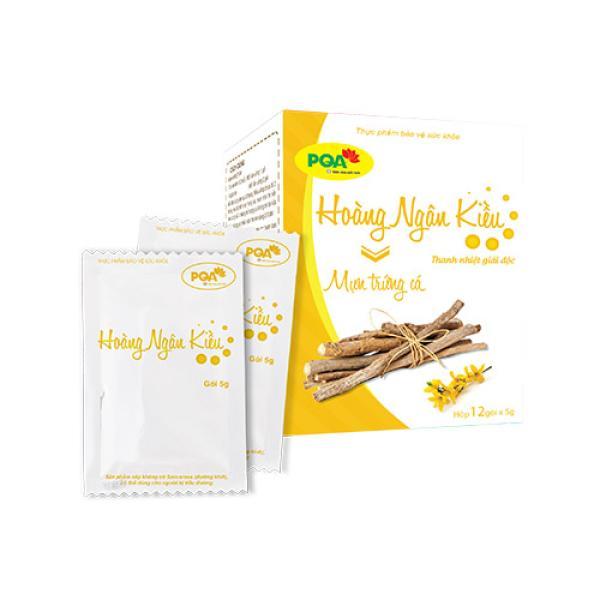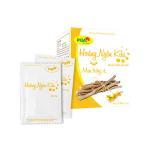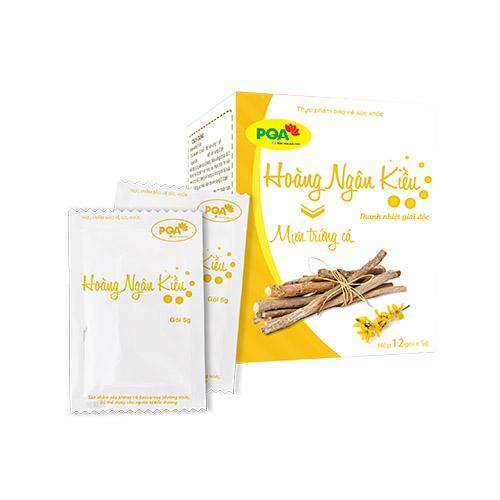MTA Hoàng Ngân Kiều
MTA Hoàng Ngân Kiều is a herbal medicine that helps to clear heat, detoxify, activate blood circulation, reduce inflammation, expel toxins, and treat abscesses for people suffering from blood heat, acne, boils, and rashes.

Ingredients of MTA Hoàng Ngân Kiều:
- Kim Ngân Hoa Extract: 650mg
- Bồ Công Anh Extract: 550mg
- Hoàng Cầm Extract: 400mg
- Gai Bồ Kết Extract: 400mg
- Liên Kiều Extract: 400mg
- Bối Mẫu Extract: 250mg
- Trần Bì Extract: 200mg
- Cam Thảo Extract: 150mg
Excipients: Adequate for 1 packet of 5g
Uses:
Helps to clear heat, detoxify, activate blood circulation, reduce inflammation, expel toxins, and treat abscesses.
Indications:
For people suffering from blood heat, acne, boils, and rashes.
Dosage:
Take 3 times a day
- Children over 12 years old: 1 packet per dose
- Adults: 2 packets per dose
Each course should last 3 months. If acne or boils are gone before 3 months, continue the full course to prevent recurrence.
For those with acne for many years, it is recommended to use 2-3 courses.
Dissolve the powder in hot water and stir until fully dissolved, then add cool water to drink.
This product does not contain Sucrose, making it suitable for people with diabetes.
If herbal residue settles, it is a good sign; stir well and finish the drink for the best results.
During use, if acne worsens, with more yellow fluid and pus, it is a good sign; continue using consistently until fully healed.
Do not use for pregnant women.
Note: This product is not a medicine and cannot replace medications.
Storage: Keep in a cool, dry place, away from light.
Do not use the product more than 4 weeks after the first opening.
Expiration Date: 3 years from the manufacturing date printed on the packaging.
Registration No: 1733/2018/ĐKSP
Quality Control No: 00759/2018/ATTP-XNQC

Fighting Acne According to the Traditional Chinese Medicine (TCM) Treatment Principles
Acne, known as "phấn thích" in TCM, is a common condition during puberty for both males and females. It is also seen during the perimenopausal period in women. The disease affects the skin and surface layers but is closely related to the internal organs. The clinical presentation is diverse, and depending on the cause, it may appear in one area or across the entire face, with varying degrees of severity—sometimes persistent or occurring in intervals. While the condition is not severe and has minimal impact on physical health, it significantly affects aesthetics and social psychology, making treatment necessary for the patient.

Acne, commonly referred to as pimples or boils, is a dermatological condition related to the sebaceous glands beneath the skin. The small openings on the skin are called pores, and the duct that connects the pores to the sebaceous glands is known as the hair follicle. Red pimples form when the hair follicles are clogged with a large amount of sebum (skin oil) and dead skin cells, leading to inflammation. Acne typically appears on the face, shoulders, back, and chest. Pimples can range from small, painless bumps (mild condition) to inflamed, swollen, and red areas (moderate condition), and in some cases, they can become painful and severe, leading to pus-filled cysts.

Symptoms and Signs of Acne
The signs and symptoms of acne depend on the severity of the condition. Some common signs include:
- Whiteheads – clogged pores that are closed.
- Blackheads – open pores where the sebum turns dark due to oxidation when exposed to air.
- Red, inflamed pimples – small, red bumps.
- Pustules – red pimples with pus at the tip.
- Cysts – large, painful pustules that form a pus-filled cyst, often hard and painful.
- Nodules – large, painful cysts that contain pus and are deeply embedded in the skin.
What Causes Acne?
The hormone Testosterone increases in both males and females during puberty, stimulating the sebaceous glands under the skin. During adolescence, sebaceous glands begin to produce more oil, leading to oily skin. However, in some individuals, this excess oil is trapped by the open pores. Bacteria, oil, and dirt clog the pores, and the trapped oil results in the formation of whiteheads. If the pores open up and are exposed to air, blackheads form, leading to inflammation and infection, which eventually results in pimples and cysts. Males typically have more oily skin than females and may experience more severe acne.
Factors That Increase the Risk of Acne
Several factors can increase the risk of developing acne, including:
- Hormonal Changes: Increased sex hormones (androgens) during puberty lead to excessive oil secretion. Androgens also increase during pregnancy. Some birth control pills contain androgens. Consult your doctor if using birth control pills.
- Certain Medications: You may be at a higher risk of acne if you are taking medications containing corticosteroids, androgens, or lithium.
- Family History: Genetics play a key role. If both parents had acne, their children are more likely to develop it as well.
- Exposure to Oil: You are at higher risk of acne if you work in greasy environments like kitchens or fryers.
- Pressure on the Skin: Contact or pressure from objects like phones, helmets, tight headbands, or backpacks can trigger acne.
- Stress: While stress does not cause acne, it can exacerbate it in those who are already prone to acne.
Traditional Chinese Medicine (TCM) Approach to Treating Acne
Treating acne with TCM is advantageous because it addresses the root causes of the condition. If the acne is due to heat, TCM aims to identify the heat's location and organ system, and then clear the heat and detoxify that area. As a result, the patient not only experiences relief from acne but also feels cooler and more comfortable, with a reduction in other heat-related symptoms such as irritability, dry eyes, dry mouth, thirst, and constipation. Additionally, TCM treatments tend to prevent acne from recurring. Since TCM uses herbal ingredients, side effects are generally fewer compared to Western anti-inflammatory medications.
Based on this theoretical framework, TCM acne treatments usually have the following effects: Clear heat, drain fire, detoxify, and nourish the blood.
The traditional herbal formula commonly used in treating acne includes ingredients such as Kim Ngân Hoa (Lonicera japonica), Liên Kiều (Forsythia suspensa), Bồ Công Anh (Dandelion), Hoàng Cầm (Scutellaria baicalensis), Gai Bồ Kết (Fructus Arctii), Bối Mẫu (Fritillaria cirrhosa), Trần Bì (Citrus reticulata), and Cam Thảo (Licorice). These herbs are used to:
- Kim Ngân Hoa: Detoxifies, alleviates allergies, and treats acne.
- Bồ Công Anh: Detoxifies, reduces inflammation, clears heat, and resolves lumps.
- Hoàng Cầm: Clears heat, dries dampness, and is used for acne.
- Gai Bồ Kết: Reduces abscesses.
- Liên Kiều: Removes pus, treats acne, and relieves itching.
- Bối Mẫu: Clears heat and resolves lumps.
- Trần Bì: Regulates Qi, clears dampness, and strengthens digestion.
Using the wisdom of these herbal treatments, MTA Hoàng Ngân Kiều has been developed by MTA Pharmaceutical Joint Stock Company to support detoxification, promote blood circulation, reduce inflammation, and expel toxins and pus. It is highly beneficial for those with blood heat, acne, boils, and rashes.
COMBINE FOR MAXIMUM EFFECTIVENESS

Kết hợp với mát gan => Thanh nhiệt, giải độc

Kết hợp với Mệnh môn thủy => Giải nhiệt toàn bộ cơ thể

Bộ sản phẩm hoàn hảo dành cho người bị Mụn trứng cá
GIỚI THIỆU DƯỢC PHẨM MTA

Dược phẩm MTA – Được sản xuất trên quy trình đạt chuẩn GMP
Đã đăng ký với FDA Hoa Kỳ

Nhà máy sản xuất dược phẩm đạt chuẩn GMP của MTA

Khu kiểm nghiệm đat chuẩn GLP của MTA
TRUYỀN THÔNG NÓI VỀ MTA

Để điều trị đạt hiệu quả tốt nhất hãy liên hệ ngay cho MTA để được hỗ trợ tư vấn sử dụng dược phẩm phù hợp và đúng cách nhất.












